
The different models of light microscopes
Modern light microscopes are usually classified based on the number of eyepieces and objectives: The binocular microscope is often used as a laboratory microscope, it is equipped with two eyepieces and one objective. With a phototube, it is used as a trinocular microscope in microscope photography.
The stereo microscope is a special light microscope, it has two eyepieces and two objectives, which can, admittedly, be combined into one main objective.
The function of a stereo microscope
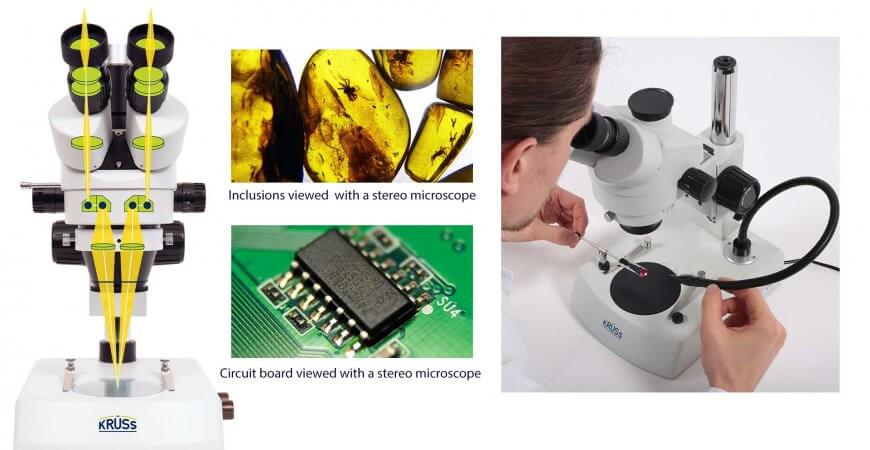
Stereo microscopes produce a separate image of the object in each eye. Both eyes see the sample from a slightly different angle, so a stereo effect occurs with two images. The human brain combines these two separate images into a unified image with a certain level of depth. This creates an almost three-dimensional appearance. The large zoom range and wide depth of field make these microscopes ideal for gemstone examination. They are used to observing internal properties and check external characteristics such as damages or the quality of cut. Another area of application is during the industrial quality control of electronic components, micromechanical and plastic products.
The function of a binocular microscope
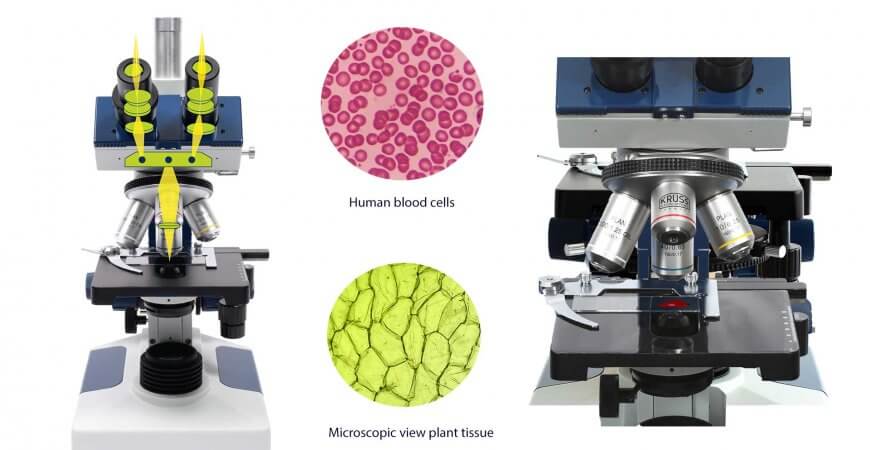
The binocular microscope produces an image with only one objective and makes it visible to both eyes, but it does not give a spatial view of the sample. Binocular microscopes are ideal for biological studies, especially microscopy of low-contrast objects, e.g. observation of microorganisms or red blood cells, or blood analysis according to Enderlein. It is also used to identify different cell structures or to perform water analysis (hydrobiology) in waters and wastewater treatment plants.
The eyepieces of microscopes
The microscopic image is zoomed first by the objective, before passing the long tube and reaching the eyepiece. It enhances the magnifying effect of the objective, but it does not provide any improvement in resolution. The eyepiece usually consists of the following components: Exit pupil (Ramsden circle), lens of eye, aperture field of view and field lens.
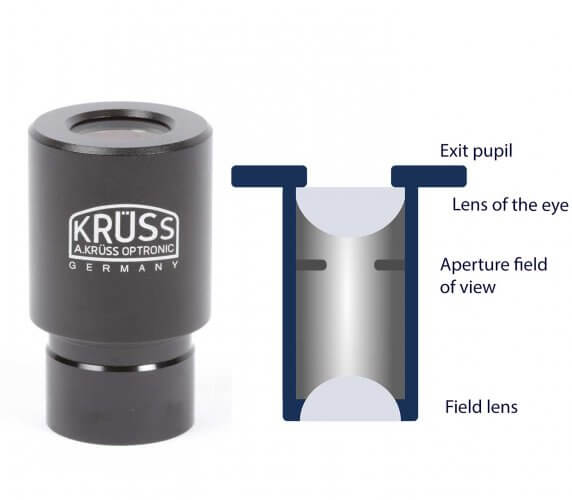
One of the lens systems fronts the eye (eye lens). The second lens system is often located at the bottem end of the eyepiece (field lens) and is used to magnify the field of view. There is also a pinhole plane in the eyepiece, in which the intermediate image is created.
In relation with the optical system of the eye, the objective projects an image onto the retina.
The condition for this is that the exit pupil of the eyepiece and the entrance pupil of the eye must be equal. The eyepiece has a magnifying effect.
The objectives - the soul of the microscope
The objective is the closest item to the sample that is being studied. It represents the first level of optical magnification and is also responsible for the resolution of the microscope.
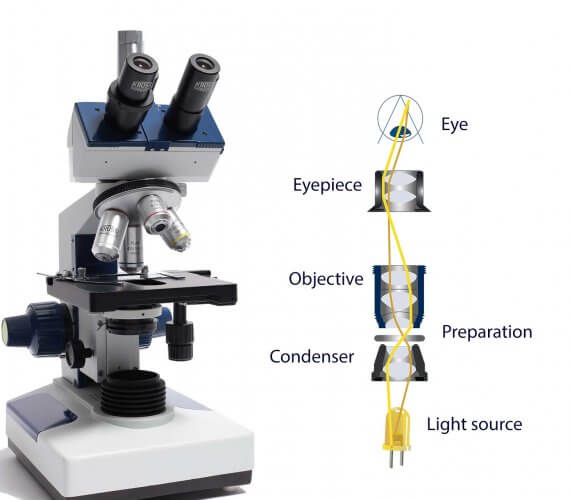
On the rotatable nosepiece, objectives are normally arranged in increasing scale number.
This has the result that the objectives becomes longer and longer and the distance to the object becomes smaller and smaller.
If the examination is started with the lowest magnification, the sample can be positioned in the centre and the nosepiece can be turned forward to the next magnification level.
Substage Condenser
The sliding stage can be adjusted in x- and y-direction. It is equipped with a hole in the middle and the condenser is located below the stage. The condenser acts like an aperture, focusing the light in order to illuminate the sample as brightly as possible. This allows the best possible projection into the beam path.
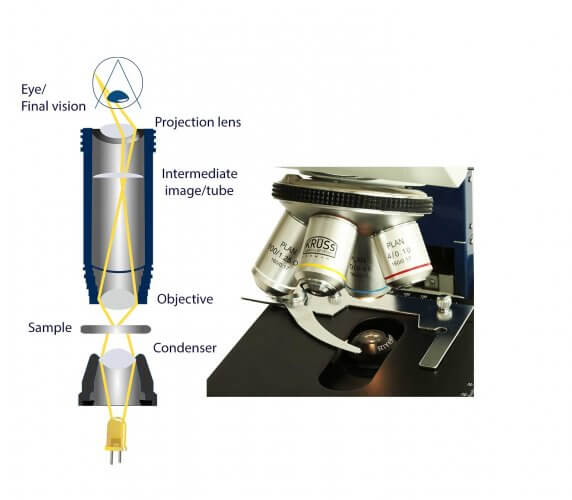
Furthermore, the condenser ensures the correct illumination level for the field of view and guarantees also using the exact numerical aperture for lighting.
With the fine and coarse adjustment, it is possible to change the level of the object stage, so the sample can be accurately examined.
The coarse drive is a large-scale wheel and is used to detect the object quickly and coarsely, the movement is performed by centimetres.
First, the focus is roughly adjusted with the coarse drive, then the further readjust is done with the fine drive, until the picture is sharp.
Illumination of the microscope
The type of microscope examination will determine which microscopy light is used. In biological and medical microscopy, the sample is illuminated from below and can thus be studied microscopically by means of the transmitted light.

For transmitted light illumination, built-in light sources are usually used. The built-in halogen illumination with 6V/20 Watt provides sufficient brightness for observation with transmitted light illumination, such as Köhler’s illumination.
This illumination also enables other common examinations such as bright-field, dark-field, phase contrast, differential interference contrast (DIC) and polarisation.
Other types of microscopic illumination
When complex examination methods are required, such as LED incident-light fluorescence or complex phase-contrast examinations, the built-in illumination is often not sufficiently powerful. Microscope photography also often requires distinctive, brighter, spot-on illumination. In these cases, other illumination equipment is used.
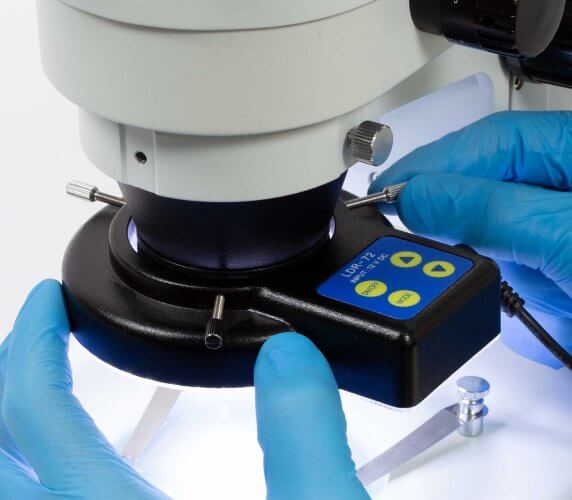
Ring lights are recommended for very bright, consistent illumination. Compared to the low-voltage light, these ring lights, mounted directly on the objective, are specialised in their low heat generation (infrared component). The LED light is ideal for live microscopy and for warmth-sensitive objects. With these lights, 360° rotation is possible, which highlights and renders a wide variety of components or textures of the sample.
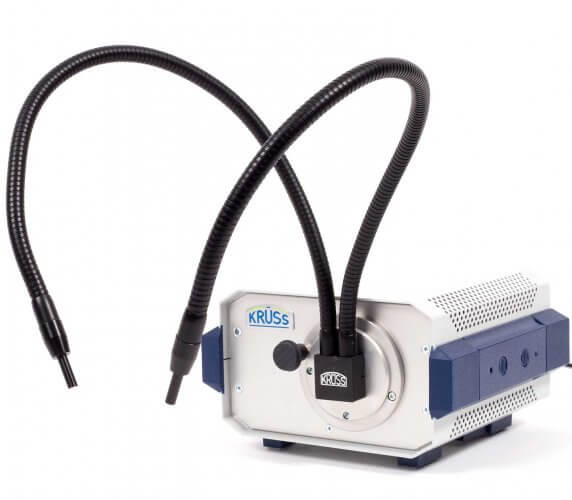
The spotlight illumination with movable goosenecks is chosen for high-contrast illumination and offers high flexibility in lighting. It is very bright and the angle of illumination is freely adjustable. In contrast to the ring light, with this type of light very steep or very flat angles are possible. Ring lights and cold light sources are also suitable for photomicrography and for flicker-free video recordings.
Phase contrast microscopy
For the human eye, a phase-contrast microscope visualises invisible phase shifts through perceptible differences in brightness. It is used to observe cells that are almost invisible in a normal light microscope. It is also applicable on diagnostic procedures.
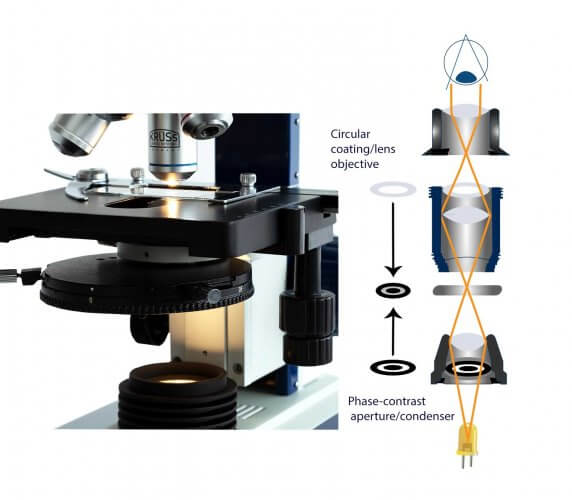
A phase contrast device has different parts: a special condenser with switchable apertures (these creates a light ring) and a special lens objective with a circular coating. This limits the incidence of light to the sample to a specific angle of incidence. Its diameter must be adapted to the lens aperture, for this reason several ring apertures (4-5) are used with different diameters. The tube is also important, it is needed to adjust the circular coating of the lens to the aperture ring.